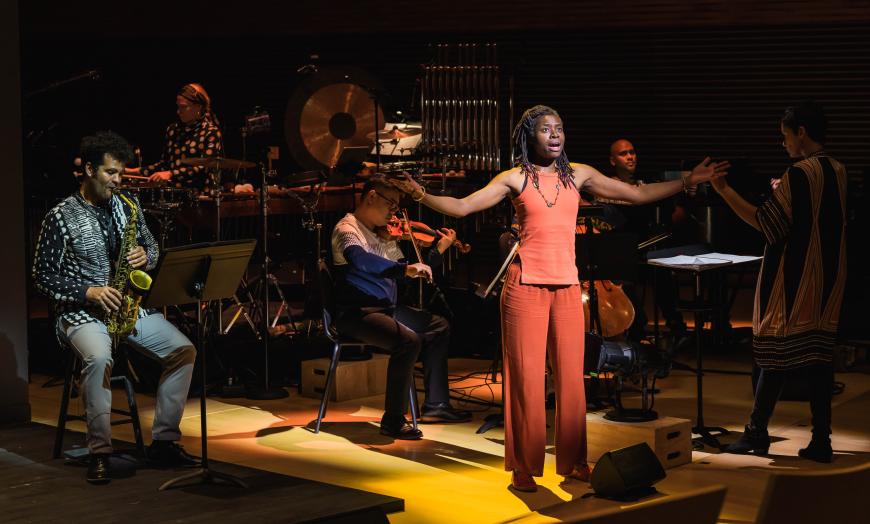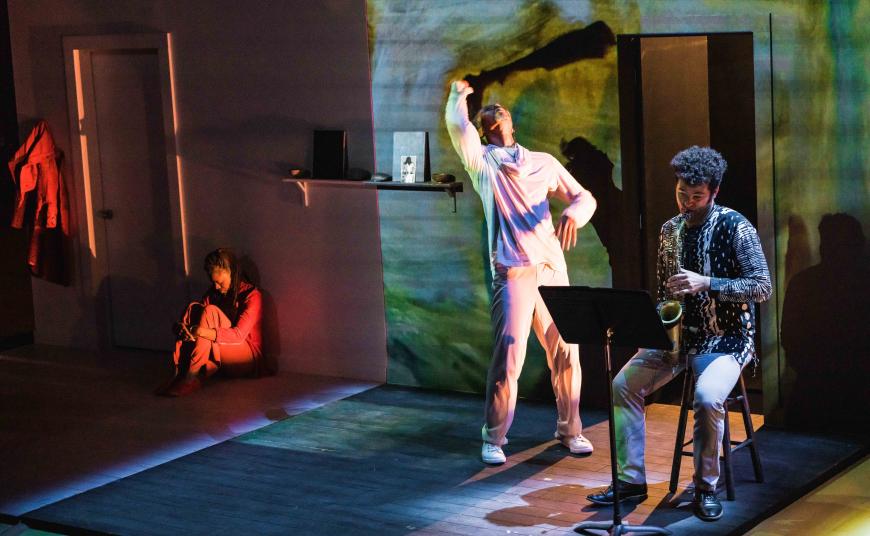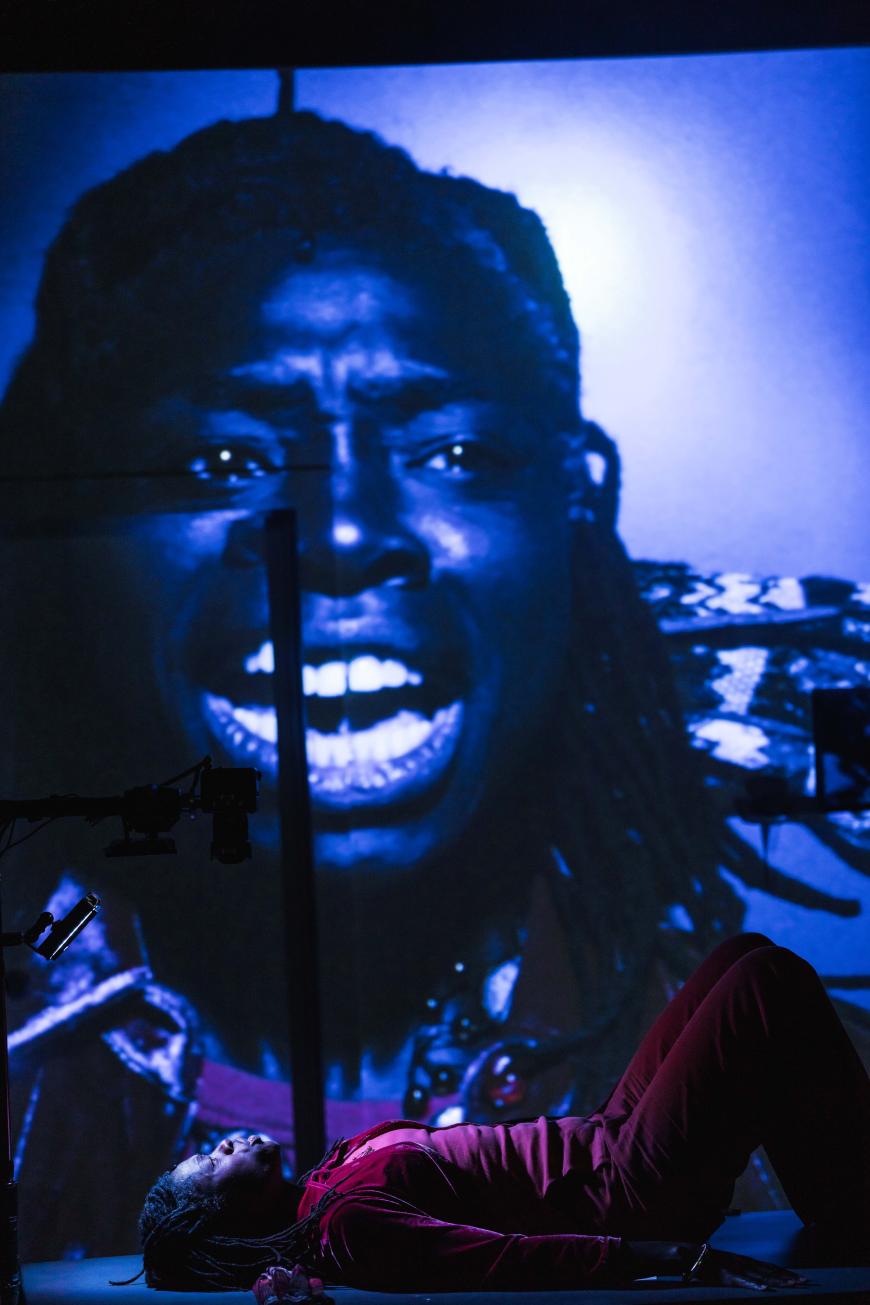
The Ritual of Breath Is the Rite to Resist, at Stanford’s Bing Concert Hall Oct. 14–15, may have had an unwieldy title. But this 80-minute work, a stirring musical monodrama rooted in racial pain and defiance, seized the mind and heart with a keenly made and resonant fusion of music, text, movement, and design.
The death of Eric Garner, an African American father of six who was choked to death by a white New York policeman in 2014 during an arrest for selling cigarettes on the street, is the ostensible subject and occasion for the piece. Through seven short movements, this Ritual expanded to become both a moving threnody for the systemic violence Garner’s death represents and a plea for communal resistance, endurance, and transformation.
In a transfixing lead performance, soprano (and co-choreographer) Neema Bickersteth sang virtually every line of Vievee Francis’s stately libretto. Jonathan Berger’s score supported and articulated the surging, insistent, and plangent vocal lines with a crisp, sometimes concussive chamber ensemble of piano, percussion, violin, cello, and saxophone. Kamna Gupta was the sensitive and disciplined conductor.

Co-conceived with Berger by visual artist Enrico Riley, the production featured a stark two-doored flat, one side white and the other black. The worktables and video equipment suggested the deconstruction aesthetic of The Wooster Group. the New York-based experimental theater company.
From its earliest moments, however, there was nothing self-conscious or metaconceptual about this piece. Through subtle emotional and rhetorical shifts in the libretto, a listener was drawn into a deeply imagined and psychologically animated space.
“Evening together,” sang Bickersteth in a dreamy voice at the outset, “we can do anything.” As the instrumental music slowly degraded into shards of dissonance, the singer lofted the word “father,” adding, “We will do anything.”
Soon enough the language slipped to another register, as an offstage chorus materialized in projected cell-phone windows. “We can’t do anything,” they lamented, “to stop this.” This, of course, being racism, injustice, and murder.
With a sense of urgency heightened by her arresting vibrato, Bickersteth navigated oscillating poles of optimism and despair, innocence and experience. As her labile feelings altered, the singer was sometimes a daughter, sometimes a sister, and sometimes a kind of roving consciousness. “The self is a wind winding through,” she reflected, in one of Francis’s many incisively poetic lines.

Garner’s name was mentioned only once, in a spoken catalog of men and women, including Oscar Grant and George Floyd, killed in confrontations with the police. The way in which Garner died, however, became a powerful image, made manifest in words, music, and action.
“To breathe is to not disappear,” the singer reflected. “Who heard him last?”
Bickersteth stood at that moment over dancer Trebien Pollard, who was lying on one side, with his legs held rigid in midair over the edge of a table. His body took on the ambiguity of death and transcendence. (Some of Francis’s libretto took on a kind of biblical aura.) The violin (Fung Chern Hwei) and saxophone (Greg Ward) exchanged a tender meditation over this haunting mystery.
There were other moments of glowing illumination as Ritual moved through its suggestively titled movements (“Fear: Among the Many More,” “A Question of Abandonment”) — perhaps too many. The piece seemed to end several times.
The resounding climax arrived with the unexpected onstage appearance of the dozen choir members to lead a rousing jazz-hymn spiritual. “Keep breathing anyway,” rang out a repeated summons. Like many lines, that challenge held a double message: Carry on the fight against racism in spite of the odds. And do it in any way possible.
Bickersteth’s heroic and transporting performance deserves praise without measure. She was truly the show’s breath of life on opening night of a two-day run. Her achievement was supported and amplified by everything around her, from the scenic and supple projection design by Peter Nigrini to Reza Behjat’s pointed lighting, all under Niegel Smith’s disarmingly simple and lucid direction.
Two performances weren’t enough. The Ritual of Breath Is the Rite to Resist deserves the kind of attention and endurance it urges so powerfully on an audience.




